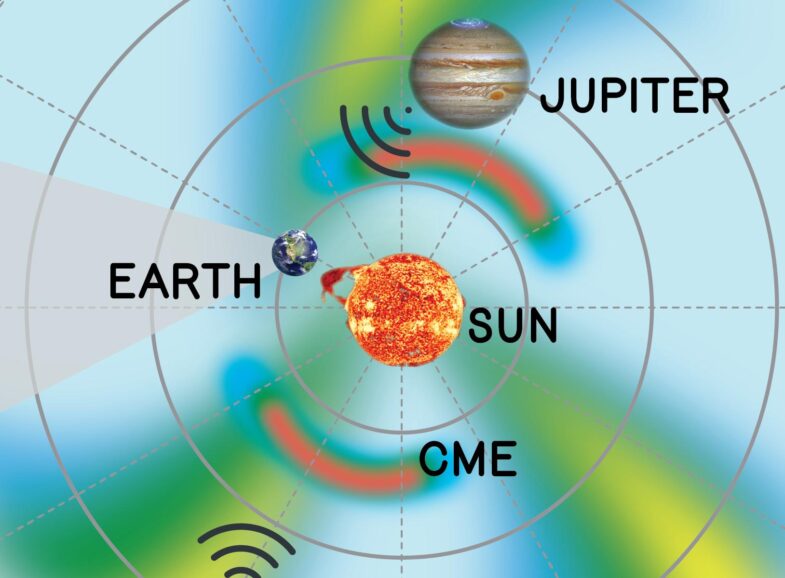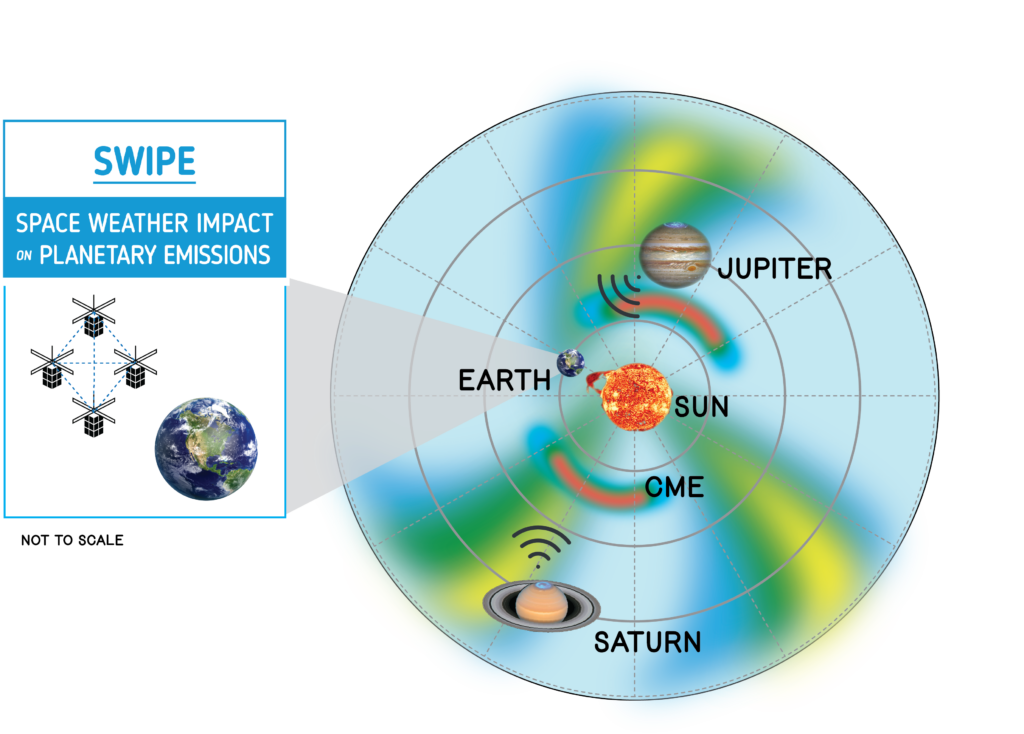
SWIPE NASA mission concept funding awarded
The Haystack space technology team has been awarded a NASA grant for the Space Weather Impact on Planetary Emissions (SWIPE) mission concept. SWIPE proposes four to six small spacecraft in a near-geostationary orbit as a “weather station” to monitor the effects of solar storms on Earth, Jupiter, and Saturn.
Earth’s aurora, or polar lights, display brilliant patterns not only in visible light, but also at radio wavelengths. Radio scientists at Haystack and elsewhere study Earth’s radio aurora to learn more about the fundamental plasma processes taking place a few hundred to a few thousand kilometers over our heads. Jupiter and Saturn also have aurora, and like ours, these aurorae change in response to external space weather—the effects of solar emissions and winds from the Sun. One type of space weather driver is a coronal mass ejection (CME), in which the Sun ejects an enormous amount of plasma accompanied by a twisted, convoluted magnetic field. SWIPE’s science mission is to observe the effects of space weather such as CMEs on other planets’ radio aurora.

Mary Knapp, the principal investigator of the SWIPE study, said, “Our mission concept is special because it would be the first long-term space weather observatory for multiple planets other than Earth. We want to set up an observing post in geostationary orbit that looks to the radio aurora of Jupiter and Saturn as ‘sensors’ for space weather in the outer heliosphere. As CMEs and other space weather events pass by, these planets should ‘light up’ in radio wavelengths.”
Knapp and Lenny Paritsky, both of MIT Haystack Observatory, will be working with space weather expert Erika Palmerio of Predictive Science Inc. on the SWIPE concept study. Palmerio, SWIPE co-investigator, said, “The study of space weather—the collective effects that solar activity has on planets and other solar system bodies—has been mainly focused on Earth. With SWIPE, we will be able to study space weather events at Earth and at the two solar system giants Jupiter and Saturn at the same time. On top of helping us understand more about how and under which conditions the Sun drives auroras at different planets, SWIPE is going to be an extremely exciting opportunity for collaborations and overlap between heliophysics and planetary science.”
SWIPE is now in the concept study phase, meaning that the team will determine what kind of instrument and spacecraft constellation architecture are required to launch the mission and achieve SWIPE’s science goals. The proposed experiment would deploy four to six SmallSats to collect data while in orbit around Earth. Gathering radio wave data is easier from space, because the satellites’ antennas will be located above Earth’s atmosphere, which can interfere with the reception of radio signals. Using multiple spacecraft increases the constellation’s sensitivity and also provides finer spatial resolution via the technique of interferometry.
Paritsky, project chief engineer, said, “SWIPE is a unique opportunity to trace the impact of space weather events like CMEs as they propagate out through the solar system—some really exciting science will come out of this mission. We’re also just starting to realize the potential of low-cost constellations of SmallSats to achieve big science goals. I’m looking forward to seeing how we can take advantage of technologies that have been rapidly advancing and miniaturizing—like propulsion systems and optical communications—to achieve SWIPE’s mission goals.”
Each satellite in the proposed constellation will include an antenna called a “vector sensor,” which can detect the direction of arrival of radio emissions in three dimensions, plus the Aurora radio, a software-defined radio receiver based on the Haystack-led AERO-VISTA auroral mission.
This mission study has been selected by NASA for funding under its Heliophysics Flight Opportunities Studies (H-FOS) program. The NASA H-FOS program “solicits proposals to enable application of new technologies (platform and/or instrumentation) to heliophysics flight missions.”
Knapp said, “We’re excited to build on the work that’s gone into the AERO-VISTA mission. Our goal has always been to build up a low-frequency radio constellation telescope, so we’re looking forward to taking this next step.”